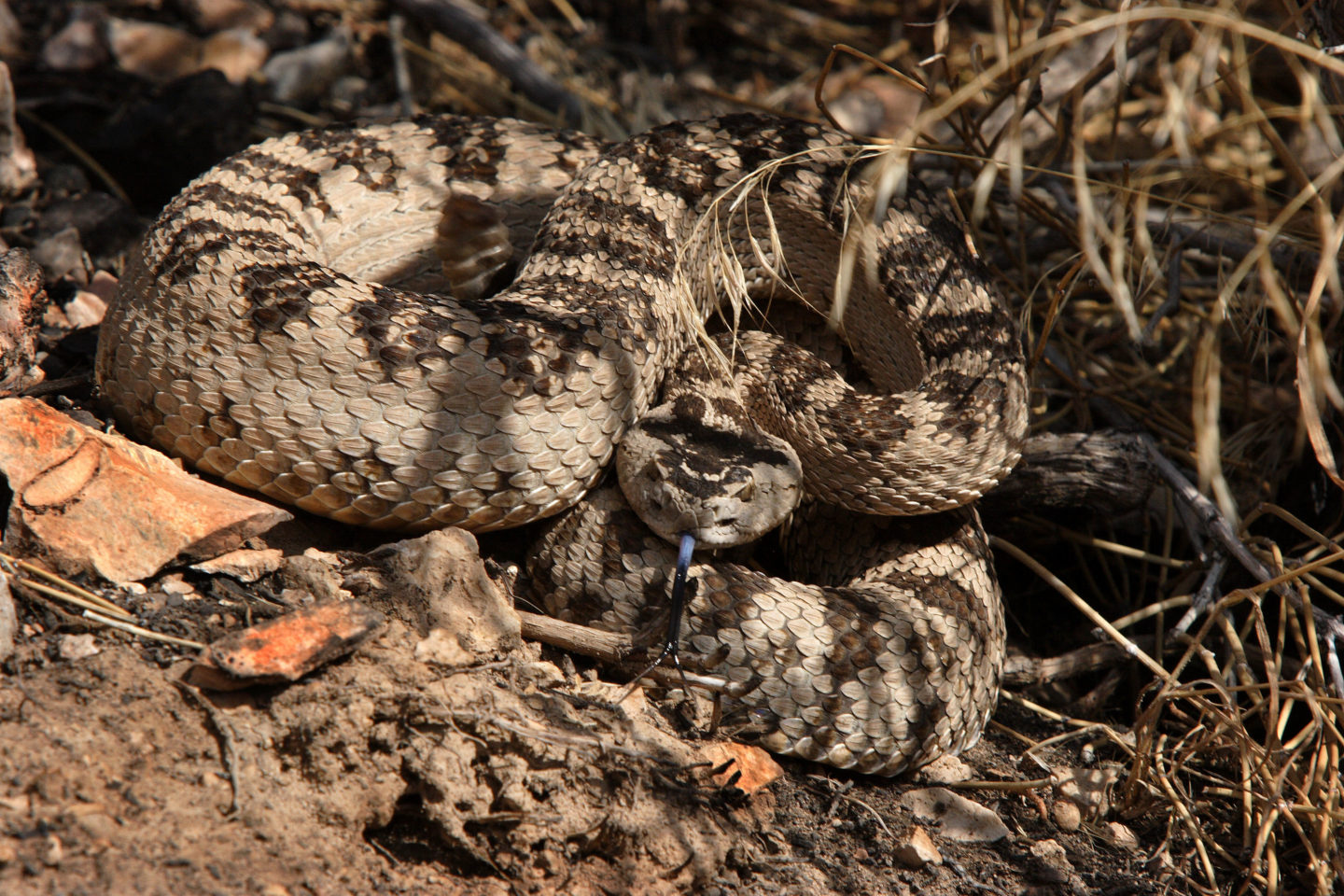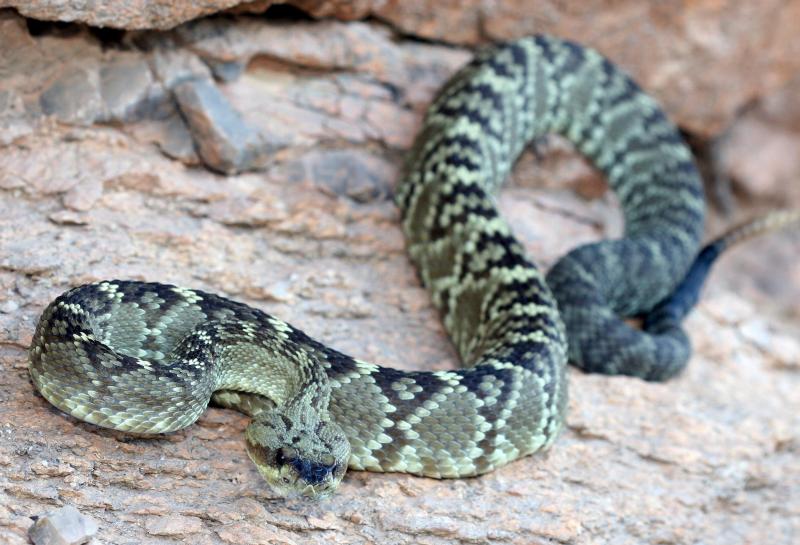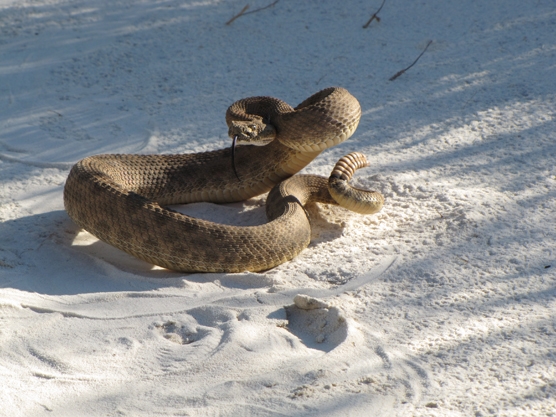Do’s and Don’ts of Hiking in Rattlesnake Territory
- Blog Do’s and Don’ts of Hiking in Rattlesnake Territory
Is your family hiking in rattlesnake territory? In this article, Maria shares do's and dont's of hiking with kids around rattlesnakes.
“Hey, Mommy! Look at me!!” my son cheerily yelled as he hopped onto some rocks off the side of the trail. Before I could say a word, I heard the unmistakable rattle and saw the quick movement of a snake jumping (luckily) away from my son. We were deep in the heart of Capitol Reef National Park's Spring Canyon, and this was my first up close and personal encounter with a rattlesnake.
As an East Coast suburban girl who had recently moved out West, I knew I needed to learn more about how to avoid rattlesnakes (other than hopes and prayers) and what to do if and when I encountered them again. Now, I've lived for several years in Colorado's front range, where rattlesnakes thrive. I know snakes strike fear in the heart of many hikers, but they don't have to ruin your fun.
 Western Diamondback Rattlesnake
Western Diamondback Rattlesnake
 Black-tailed Rattlesnake
Black-tailed Rattlesnake
 Prairie Rattlesnake
Prairie Rattlesnake
 Western Diamondback Rattlesnake
Western Diamondback Rattlesnake
Here are some of my top DO’s and DON'Ts for hiking in rattlesnake country. Hopefully they will help you as you and your children enjoy your own trails.
DON’T: Stress too much
According to the U.S. Department of Wildlife and Ecology, your chances of dying from a venomous snake bite in the US is basically zero (1 in 50 million). You are more likely to be struck by lightning, in fact. Fewer than one in 37,500 people are even bitten by venomous snakes in the US. So, be smart, be educated, and make good choices, but understand that you are pretty unlikely to be harmed by a snake.DO: Know your area. Where do snakes live, and are they dangerous?
In the area where we live, there is only one venomous snake, the prairie rattlesnake. I've learned which parks tend to be their favorites and save the particularly snakey spots for hikes in the colder months. I also avoid hiking with young children or toddlers in the areas that are most heavily loaded with snakes that can’t easily be spotted. Fortunately, in Colorado, rattlesnakes don't get above around 9,000 feet, so I can pretty much avoid them by heading up high during the warmer months.DO: Choose wide, popular trails in areas where snakes are a concern
During snake season, particularly if I am hiking with my kids, I try to choose wider trails where we can more easily spot a rattlesnake. They are also less likely to be on crowded trails, so picking a busier place also lowers the chance of a close snake encounter. They want to avoid us!! I also try to stay away from rocky areas where I might not be able to see where I'm putting my hands or feet. Black-tailed Rattlesnake
Black-tailed Rattlesnake
DO: Keep kids on trail and close by
Some kids like to wander off trail, but in areas with rattlesnakes, it's important to keep them on trail and near an adult. I teach my kids to be "snake awake", but sometimes they forget, so I try not to let them run ahead of me. I will lead or walk right next to them in rattlesnake areas. Little rock climbers should be taught to always watch where their hands are going to avoid surprising a snake on a rock, where they like to sun themselves. Before we start a hike, I always ask my kids to tell me what they should be on the lookout for...snakes, bears, mountain lions, fast water....they all come with their own rules that the kiddos need to follow and be reminded of.DO: Wear sturdy boots and consider bringing trekking poles
If we are hiking in a rattlesnake area, I always wear my boots and insist that my kids do, too. It's just an added layer of protection and height in case of a run-in with a snake. I also feel more comfortable bringing trekking poles, particularly if a trail is narrow, to probe for snakes.DON'T: Approach snakes
Rattlesnakes want to get out of your way. They can often hear the vibrations of the ground from your footsteps and move away before you get near them. Sometimes they are caught off guard, though, and remain on or near the trail. If you see or hear a snake, the best thing to do is to stop, assess the situation, slowly back away, and wait at a safe distance for the snake to leave. If there is a way to detour far around the snake, that's a good option too. Don't try to scare the snake away, approach the snake, or move the snake. Just let it be, and let it leave. Prairie Rattlesnake
Prairie Rattlesnake
DON’T: Treat snake bites
While it's pretty rare to get bitten by a rattlesnake, if the unthinkable happens, the best thing to do is to dial 911 or send someone else to get help if you don't have a cell phone signal. Medical care is needed as soon as possible, and amateur treatments can make it worse. Avoid physical exertion as much as you can, and seek professional help. and, most importantly....DON’T: Let snakes keep you from getting out on the trails
It's important to realize that rattlesnakes are not out to hurt you. They would much rather slink away in the grass. Be on the lookout, be smart, keep your kids close, and choose trails where you can spot them during their high season, but, by all means, get out there and enjoy nature!! What's the best way to tacke a hike in rattlesnake territory? With a group! Connect with a community of like-minded families by making a membership level donation to Hike it Baby. Learn more about membership levels and join today!For more reading on hiking in rattlesnake country, here are some useful resources:
https://hikeitbaby.com/ask-the-expert-rattlesnakes-on-the-trail/ http://ufwildlife.ifas.ufl.edu/venomous_snake_faqs.shtml http://www.wta.org/signpost/how-to-hike-in-rattlesnake-country http://www.wikihow.com/Avoid-a-Rattlesnake-AttackPhoto Credits: NPS Public Domain,
About Hike it Baby
Hike it Baby is a 501(c)(3) non-profit organization dedicated to getting families outdoors and on trails across the U.S. and internationally, supporting, educating and inspiring families through their more than 300 communities across North America. More information on memberships, making a donation, and daily hike schedules can be found at HikeitBaby.com.Related Content




Comments